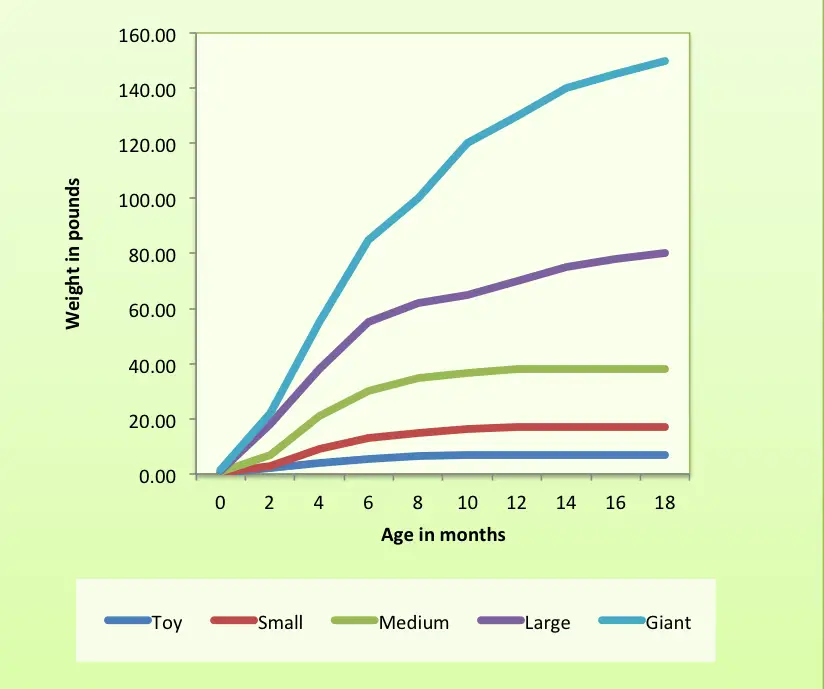If you ever want to estimate how big your little pup may get, there are several ways.
You can calculate your dog’s weight using the formula below.
Take the dog’s weight in pounds (at a certain age) and divide it by his age in weeks, then multiply that number by 52 (the number of weeks in a year). This should predict your pup’s ideal adult weight.
- Weigh Small breeds at 12 weeks old
- Medium-sized breeds Weigh at 16 weeks old
- Weigh Large breeds at 20 weeks old
How much will my dog weigh?
We use the following equation to estimate how big your dog will get.
Adult weight = (Puppy weight / Puppy age in weeks) * 52
Why multiply by 52?
52 is the number of weeks in a year. That’s how we program the dog size calculator to give us your puppy’s weight when he is exactly one year old.
On average, dogs mature into adults within 12 months, therefore, we this value in our puppy calculator. This value ranges from 8 months for smaller breeds to around 16 months for larger breeds.
Your dog’s weight category
According to your puppy weight calculator’s results, we can place your dog into one of 5 major breed size groups:
| Toy dog | < 12 lb / < 5.4 kg |
| Small dog | 12 – 22 lb / 5.4 – 10 kg |
| Medium dog | 22 – 57 lb / 10 – 25.9 kg |
| Large dog | 57 – 99 lb / 25.9 – 44.9 kg |
| Giant dog | >99 lb / >44.9 kg |
Puppy Adult Weight Calculator
Do you want a prediction of how big your puppy will get? Please enter the details in the puppy weight calculator to estimate how many pounds the dog will weigh when he reaches maturity.
Fill in the details in the calculator and hit submit to get the results below.
Enter your puppy’s age and weight.
Your puppy will weigh between lb and lb once they are fully grown.
Puppy weight calculator metrics
Pounds and ounces are the United States and imperial customary weight measurements.
1(lb) pound is equal to 0.45 kilos.
One kilo is also equal to 35.27 ounces(oz)
A medium-sized dog weighs 8 lbs. at 16 weeks.
How much will he weigh as an adult?
8 (lbs.) divided by 16 (weeks) equals 0.5
Multiply 0.5 by 52 (0.5 x 52) = 26 lbs. predicted adult weight.
Let’s try again with a small dog weighing 3 lbs. at 12 weeks old
3 divided by 12 = 0.25
0.25 x 52 = 13 lbs. predicted adult dog

Predict how big your dog will get using a puppy weight calculator
A puppy weight calculator like the one above is supposed to give you an estimate of what your pup is going to weigh once fully grown.
You should note that the results you get from the puppy weight calculator will not be completely accurate as it is a tool to help you make a prediction. It is, however, essential in the planning for your puppy.
This helps to know how much space the dog will need.
The puppy’s weight is going to be affected by several factors such as;
- Breed
- Diet
- Amount of exercise
Can I use my puppy’s paws to predict the weight?
You can also use your pup’s paw to estimate how big he will get. This may not be as accurate, but larger paws usually mean that your pup will be taller and weigh more, and smaller paws will mean the pup will grow up to be shorter and lighter.
However, as I mentioned above this is not entirely accurate as there are some large dog breeds such as Ridgebacks that have small paws. Consequently, there are also smaller breeds such as Basset Hounds that have larger paws.
When does a puppy stop growing?
Large dogs like the Great Dane take longer to grow and reach full weight than smaller dogs like the Mini-Bulldog.
Large, giant, and medium-sized dogs take about 12 to 24 months to reach maturity, while smaller ones should be fully grown between 9 and 12 months.
Some toy dog breeds can even take only six months to reach their full weight.
So, is breed the only factor that affects the size of a dog once fully grown? No. Other factors come into play when as far as a dog’s weight when fully grown.
These factors are;
- Gender.
- Desexing age.
- Diet.
- Exercise and other environmental factors.
- Breed
- Weight of the parents.
- Litter size.
Calculate your pup’s weight by breed.
There are a couple of things that can guide you to predict the size of your pup other than using the puppy weight calculator.
The breed of your puppy is one of them.
A newborn puppy will double its weight after the first week and gain about 5% of its weight every day after the first week.
By six weeks of age, smaller dog breeds gain about 6 ounces per week, while larger breeds like the Bernese Mountain dog can gain up to 2 pounds and 5 ounces every week.
Large and medium-sized breeds
Large-sized dog breeds take longer to reach full maturity with the fastest growth period between 0 and 20 weeks of age. Medium-sized breeds take a shorter period to reach their full weight and have their fastest growth rate in the 0 to 15-week period.
For these dogs, you need to wait until the puppies are about 14 weeks old before you make any weight predictions.
Other than the dog weight calculator above, you can also make the weight estimate by calculating using the formula below. This might be slightly complicated.
You take the puppy’s weight at 14 weeks, double the weight, and add half of the weight at 14 weeks to get an estimate of how much the puppy will weigh when fully grown. The formula is as follows;
(Weight at 14 *2) + (weight at 14 weeks/2)
For example, if your puppy weighs 10 pounds at 14 weeks. This will be (10 * 2) + (10/2), meaning the pup will weigh about 25 pounds once fully grown.
You can also use your puppy’s weight at six months of age to estimate the weight. At six months, a medium-sized dog breed will have reached a third of what he will weigh at maturity.
For larger breeds like Great Danes, the 6-month period is when they are about half of what they are supposed to weigh.

Small and toy dog breeds
Small and toy breeds grow the fastest at the age of between 0 and 12 weeks.
For these dogs, you need to wait until they are about six weeks old before doing the weight calculations.
You simply need to take their weight at this period double it then double it again.
(weight at six weeks * 2)*2
Age at desexing
Desexing is the removal of part or the whole of a dog’s reproductive parts. In males, it is known as neutering; in female dogs, it is known as spaying.
Neutering and spaying dogs also affect their size.
When you remove your puppy’s hormones, their bones may not receive the message that they need to stop growing. This means they continue to grow past when they are not supposed to, resulting in a taller dog.
Doing this may, however, lead to some development complications of the orthopedic tissues and joint alignment.
It is also worth mentioning that you should never desex your dog if it is not a professional doing it.
Nutrition and feeding
What you feed your dog greatly affects how big he gets.
But puppies start to feed once they are born, and their mother’s milk is essential. This milk (colostrum) contains fats and proteins that are important for the development and growth of newborn pups.
The lack of this milk can significantly stunt their growth.
During the weaning period, these puppies will need to be fed on a high-quality diet to meet their nutritional requirements.
Gender of your pooch
Sex affects the size of dogs, and because of sexual dimorphism, male dogs grow to become bigger than their female counterparts.
This difference in size is highly noticeable during the early stages of the pup’s adolescence.
If you want a canine friend to be smaller, you should get a female puppy or vice versa.
Exercise and the environment
When you over-exercise your pup, you may cause damage or injury to their ligament and skeleton, which could impede their growth.
Exercise is important for a developing puppy, but overdoing it is disastrous.
Litter size
Smaller dog breeds tend to have larger litters.
With time, the size of your litter will affect their growth.

Meet the parents
Meeting the parents of your puppies is your best chance at knowing your dog’s size.
Your puppy is most likely going to take after the parent’s size mainly due to genetics.
Puppy weight calculator summary
If you provide your puppy with the correct care and meet their diet requirements, they will grow to the desired size.
Go to the vet regularly to get your health checked, and use the puppy weight calculator above to estimate what he will weigh once he is fully grown.
Did you like the insights we gave you?
If you did give us your feedback and questions in the comment section below.
There you go WOOF!!